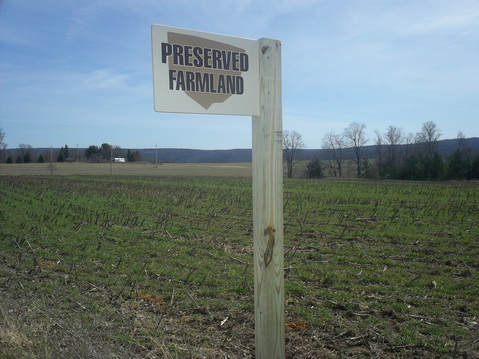Program Overview

The Pennsylvania Agricultural Conservation Easement Purchase Program was developed in 1988 to help slow the loss of prime farmland to non-agricultural uses. The program enables state, county and local governments to purchase conservation easements (sometimes called development rights) from owners of quality farmland. The state currently has 5,071 farms preserved which includes 531,025 acres. The first easements were purchased in 1989. Counties participating in the program have appointed agricultural land preservation boards with a state board created to oversee this program. The state board is responsible for distribution of state funds, approval and monitoring of county programs and specific easement purchases.In 1994 the Commissioners of Sullivan County established a seven member board consisting of three farmers, one local government representative, one building industry representative and two citizens at large to develop and oversee an easement program for Sullivan County. The Sullivan County Agricultural Land Preservation Board purchases development rights or easements from farmers in Sullivan County. After an application is submitted and the application fee is paid, it will be checked to make sure that all minimum requirements are met (see minimum eligibility criteria below). If all minimum requirements are met, the board will complete an on-site assessment. The application will be scored with the Land Evaluation and Site Assessment system (LESA). The LESA system provides a way to rank the easement applications by evaluating soil and locational factors for each tract. These factors include development pressure and likelihood of impact of future development. The application with the highest LESA score will be appraised first, followed by the next highest LESA score, and so on.
Based on the appraisal, the Board will make the landowner an offer for their development rights. If both parties (the Board and the landowner) agree on the figure, the easement will be purchased using local and state dollars. The landowner will receive the money agreed to in the contract. They will still own the land, but because they no longer own the development rights, agricultural production will be the only future use of the land. A soil conservation plan must be followed when farming the property. Currently the county has 7 farms preserved which includes 649 acres.
Based on the appraisal, the Board will make the landowner an offer for their development rights. If both parties (the Board and the landowner) agree on the figure, the easement will be purchased using local and state dollars. The landowner will receive the money agreed to in the contract. They will still own the land, but because they no longer own the development rights, agricultural production will be the only future use of the land. A soil conservation plan must be followed when farming the property. Currently the county has 7 farms preserved which includes 649 acres.
Program Requirements
Minimum Eligibility Criteria
- Be located in an Agricultural Security Area which has at least 500 acres enrolled which include Fox, Forks, Elkland, Cherry, and Shrewsbury Townships. Colley Township is included now with Cherry Township ASA.
- Be contiguous acreage* of at least 50 acres in size unless the tract is at least 10 acres in size and is either utilized for a crop unique to the area or is contiguous to a property which has a perpetual conservation easement in place which is held by a “qualified conservation organization,” as that term is defined at Section 170 (h) of the Internal Revenue Code.
*Contiguous Acreage is defined as all portions of one operational unit as described in the deed, or deeds, whether or not the portions are divided by streams, public roads, bridges, and whether or not described as multiple tax parcels, tracts, purparts, or other property identifiers. It includes supportive lands such as unpaved field access roads, drainage areas, border strips, hedgerows, submerged lands, marshes, ponds, and streams. - Contain at least 50% of soils which are available for agricultural production and are of capability classes I through IV, as defined by the USDA - Natural Resource Conservation Service. Acreage may need to be excluded.
- Contain the greater 50% or 10 acres of harvested cropland, pasture or grazing lands.
